Agriculture is a primary activity. It includes growing crops, fruits, vegetables, flowers and rearing of livestock. In the world, 50 per cent of persons are engaged in agricultural activity. Two-thirds of India’s population is still dependent on agriculture.
Note – The land on which the crops are grown is known as arable land
Important Term
Agriculture – The science and art of cultivation on the soil, raising crops and rearing livestock. It is also called farming
Sericulture – Commercial rearing of silk worms. It may supplement the income of the farmer
Viticulture – Cultivation of grapes
Pisciculture – Breeding of fish in specially constructed tanks and ponds
Horticulture – Horticulture Growing vegetables, flowers and fruits for commercial use.
Olericulture – Study of vegetable science
Green Revolution – It stands for a major technological breakthrough in India based on (i) improved seeds of high yielding varieties, (ii) adequate and assured supply of water for irrigation, and (iii) increased and appropriate application of chemical fertilizers for increasing agricultural production
White Revolution – It stands for remarkable increase in milk production
Blue Revolution – It refers to big rise in catching of fresh water and marine fish
Yellow Revolution – It refers to remarkably steady and assured supply of poultry products
Pink Revolution – It refers to a considerable rise in the production of quantity of apples particularly in the states of Himachal Pradesh and J&K
Black Revolution – Petroleum Production
Brown Revolution – Leather/non-conventional(India)/Cocoa production
Golden Fibre Revolution – Jute Production
Golden Revolution – Fruits/Overall Horticulture development/Honey Production
Grey Revolution – Fertilizer
Red Revolution – Meat & Tomato Production
Round Revolution – Potato
Silver Fiber Revolution – Cotton
Silver Revolution – Egg/Poultry Production
Evergreen Revolution – Overall development of Agriculture
Soils of India: Six Different Types of Soils Found in India are as follows:
Soil is our prime natural and economic resource. Soils in India differ in composition and structure.
1. Alluvial Soils:
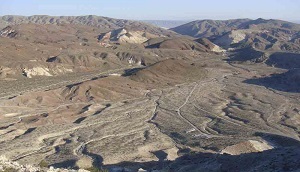 largest and the most important soil group of India
largest and the most important soil group of India- These are formed by the deposition of sediments by rivers.
- They are rich in humus and very fertile.
- They are found in Great Northern plain, lower valleys of Narmada and Tapti and Northern Gujarat.
- These soils are renewed every year.
Influence on Agriculture: Alluvial soil is very productive. Abundant of wheat, sugarcane, oilseeds, pulses, rice and jute is grown on this soil.
2. Black Soils:
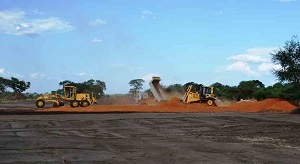 These soils are made up of volcanic rocks and lava-flow.
These soils are made up of volcanic rocks and lava-flow.- It is concentrated over Deccan Lava Tract which includes parts of Maharashtra, Chhattisgarh, Madhya Pradesh, Gujarat, Andhra Pradesh and Tamil Nadu.
- It consists of Lime, Iron, Magnesium and also Potash but lacks in Phosphorus, Nitrogen and Organic matter.
Influence on Agriculture: They retain moisture for a long period. These soils are fertile and suitable for the production of cotton, sugarcane, wheat and groundnut.
3. Red Soils:
 These are derived from weathering of ancient metamorphic rocks of Deccan Plateau.
These are derived from weathering of ancient metamorphic rocks of Deccan Plateau.- Its redness is due to iron composition. When iron content is lower it is yellow or brown.
- They cover almost the whole of Tamil Nadu, Andhra Pradesh, Chhattisgarh, Karnataka, Maharashtra and parts of Orissa.
Influence on Agriculture: They are relatively less fertile, but are capable of growing good crops with the help of irrigation and fertilizers. Rice, wheat, millet, gram, pulses, sugarcane, oilseeds and cotton are cultivated on these Soils.
4. Laterite Soils:
 These soils are formed due to intense leaching and are well developed on the summits of hills and uplands.
These soils are formed due to intense leaching and are well developed on the summits of hills and uplands.- They are commonly found in Kerala, Tamil Nadu, Maharashtra, Chhattisgarh and hilly areas of Orissa and Assam.
Influence on Agriculture: These soils are infertile as they cannot retain moisture. They are unsuitable for agriculture. Some plants like the cashew can thrive on lateritic soils. Root crops like tapioca also do reasonably well on these soils
5. Mountain Soils:
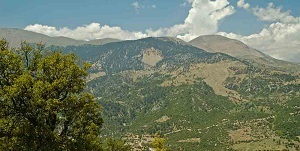 These soils are formed as a result of the accumulation of organic matter derived from forest growth.
These soils are formed as a result of the accumulation of organic matter derived from forest growth.- They are found in Himalayan region and vary in different regions according to altitude.
- Tea is grown in those areas which receive sufficient rainfall.
Influence on Agriculture: They are fertile and suitable for cultivation of potatoes, rice, wheat, fruits and tea.
6. Desert Soils:
 In the desert regions of Rajasthan, soils are not well developed.
In the desert regions of Rajasthan, soils are not well developed.- As evaporation is in excess of rainfall, the soil has a high salt content and saline layer forms a hard crust.
- These soils are generally sandy and deficient in organic matter.
Influence on Agriculture: These soils are not suitable for agriculture due to scanty rainfall; however, agriculture can be carried on with the help of irrigation. Bajra, wheat, groundnut can be grown on these soils.
| Points to remember | Type of Soil |
|---|---|
| The soil most common in Indo-gangetic plains | Alluvial |
| The soil which swells when wet and develops cracks when dry | Black |
| The soil which owes its colour to oxides of iron | Laterite |
| The soil which requires least use of fertilisers | Alluvial |
| The soil which requires least tilling | Black |
| The kind of soil which is treated with gypsum to make it suitable for cropping | Alkaline soil |
| The soil which is poor in soluble salts | Laterite |
| The soil which is rich in surface accumulation of organic matter | Peaty soil |
| The soil which is most suitable for cultivation of cotton | Black |
Rabi: Rabi crops are also known as winter crops.
Sown – October to December and
Harvested – April to June.
Main Crop – Wheat, barley, pea, gram and mustard.
Note – Punjab, Haryana, Himachal Pradesh, Jammu & Kashmir, Uttarakhan and Uttar Pradesh are the important producers of rabi crops.
Kharif: Kharif crops are also known as summer crops.
Sown – The beginning of monosoon
Harvested – September-October.
Main Crop – Paddy, maize, jowar, bajra, tur, moong, urad, cotton, jute, groundnut and soyabean crops.
Note – Assam, West Bengal, coastal regions of Orissa, Andhra Pradesh, Tamil Nadu, Kerala, Maharashtra, Uttar Pradesh and Bihar are important rice growing states.
Note – In Assam, West Bengal and Orissa, three crops of paddy are grown in a year. These are called Aus, Aman and Boro.
Zaid: The zaid season falls in between the rabi and kharif seasons.
Main Crop – Watermelon, muskmelon, cucumber, vegetables and fodder crops
Note – Sugarcane is planted in this season but takes almost a year to grow.
Based on climatic condition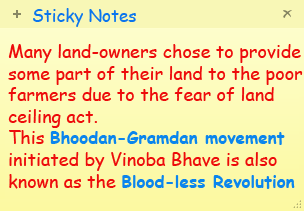
1) Tropical crop : Coconut, sugarcane
2) Sub-tropical crop : Rice, cotton
3) Temperate crop : Wheat, barley
4) Polar crop : All pines, pasture grasses
Farm System Agriculture
Inputs – seeds, fertilisers, machinery and labour.
Operation – Ploughing, sowing, irrigation, weeding and harvesting.
Output – crops, wool, dairy and poultry products.
Farming Type
Farming can be classified into two main types.
1.Subsistence Farming
- Intensive Subsistence
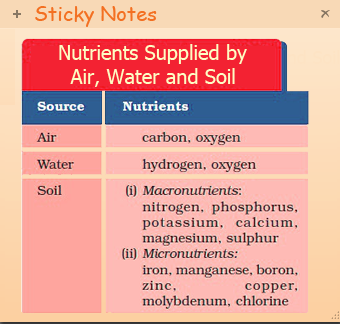
- Primitive Subsistence
- Shifting Cultivation
- Nomadic Herding
2.Commercial Farming.
- Commercial Frain Farming,
- Mixed Farming
- Plantation Agriculture.
1. Subsistence Farming –
- This type of farming is practised to meet the needs of the farmer’s family.
- Traditionally, low levels of technology and household labour are used to produce on small output.
Subsistence farming can be further classified as Intensive Subsistence and Primitive Subsistence Farming.
In Intensive Subsistence Agriculture –
- The farmer cultivates a small plot of land using simple tools and more labour.
- Climate with large number of days with sunshine and fertile soils permit growing of more than one crop annually on the same plot.
- Rice is the main crop.
- Other crops include wheat, maize, pulses and oilseeds.
Primitive Subsistence – agriculture includes shifting cultivation and nomadic herding.
Shifting Cultivation
- These are the areas of heavy rainfall and quick regeneration of vegetation.
A plot of land is cleared by felling the trees and burning them. - The ashes are then mixed with the soil and crops like maize, yam, potatoes and cassava are grown. After the soil loses its fertility, the land is abandoned and the cultivator moves to a new plot.
- Shifting cultivation is also known as €˜slash and burn’ agriculture.
Note – Shifting cultivation is known by different names in different parts of the world Jhumming – North-East India Milpa -Mexico Roca – Brazil. Ladang – Malaysia
Nomadic Herding
- Practised in the semi-arid and arid regions of Sahara, Central Asia and some parts of India, like Rajasthan and Jammu and Kashmir.
- In this type of farming, herdsmen move from place to place with their animals for fodder and water, along defined routes.
- This type of movement arises in response to climatic constraints and terrain. Sheep, camel, yak and goats are most commonly reared.
- They provide milk, meat, wool, hides and other products to the herders and their families.
2. Commercial Farming –
- In commercial farming crops are grown and animals are reared for sale in market.
- The area cultivated and the amount of capital used is large.
- Most of the work is done by machines.
Commercial farming includes Commercial Frain Farming, Mixed Farming and Plantation Agriculture.
Commercial Grain Farming –
- Crops are grown for commercial purpose.
- Wheat and maize are common commercially grown grains.
- Severe winters restrict the growing season and only a single crop can be grown.
Mixed Farming –
- It is a situation in which both raising crops and rearing animals are carried on simultaneously.
- Here farmers engaged in mixed farming are economically better of than others
Plantations –
- It is an estate where a single cash crop is grown for sale.
- This type of agriculture involves growing and processing of a single cash crop purely meant for sale. Tea, coffee, rubber, banana and spices are all examples of plantation crops
Note – Organic Farming In this type of farming, organic manure and natural pesticides are used instead of chemicals. No genetic modification is done to increase the yield of the crop.
MAJOR CROPS OF INDIA
Food grains – Crops that are used for human consumption
Main Crop – Rice, Wheat, Maize, Millets, Pulses and Oil seeds
Commercial Crops – Crops which are grown for sale either in raw form or in semi-processed form
Main Crop – Cotton, Jute, Sugarcane, Tobacco and Oilseeds
Plantation Crops – Crops Which are grown on Plantations covering large estates
Main Crop – Tea, Coffee, Coconut and Rubber
Horticulture – Sections of agriculture in which Fruits and Vegetables are grown
Main Crop – Fruits and Vegetables
Let us discuss the Important Food grains
Rice – Kharif or Summer Crop
Temperature Require: Rice requires hot and humid conditions. The temperature should be fairly high i.e. 24°C mean monthly temperature with average temperature of 22°C to 32°C
Rainfall: Rainfall ranging between 150-300 cm is suitable for its growth in areas of Punjab, Haryana and Western Uttar Pradesh where rainfall is less than 100 cm, rice is cultivated with the help of irrigation.
Soil: Rice is grown in varied soil conditions but deep clayey and loamy soil provides the ideal conditions. Rice is primarily grown in plain areas. It is also grown below sea level at Kuttinad (Kerala), hill terraces of north eastern part of India and valleys of Kashmir
Note – China leads in the production of rice followed by India, Japan, Sri Lanka and Egypt.
Wheat – Rabi or Winter Crop
Temperature Require: It is primarily a crop of mid-latitude grassland. It requires cool climate. The ideal temperature is between 10°C to 15°C at the time of sowing and 21°C to 26°C at the time of ripening and harvesting.
Rainfall: Wheat thrives well in areas receiving annual rainfall of about 75cm. Annual rainfall of about 100cm is the upper limit for wheat cultivation
Soil: Although wheat can be grown in a variety of soils but well drained fertile loamy and clayey loamy soil is best suited for wheat cultivation. Plain areas are very well suited for wheat production.
Note – Wheat is grown extensively in USA, Canada, Argentina, Russia, Ukraine, Australia and India. In India it is grown in winter.
Millets(Jawar, Bajra): Millets are short duration warm weather crops – Kharif Crop
Temperature Require: These crops are grown where the temperature is high which ranges between 27°C to 32°C.
Rainfall: As mentioned earlier that millets are €˜dry land crops’, therefore, rainfall ranging from 50 to 100cm is ideal for their cultivation.
Soil: Millets are less sensitive to soil deficiencies. They can be grown in inferior alluvial or loamy soil
Pulses-
Note – Gram: It is the most important of all the pulses. It accounts for about 37% of the production and about 30% of the total area of pulses in India
Temperature Require : It is grown in a wide range of climatic condition. Mild cool and comparatively dry climate with 20°C-25°C temperature.
Rainfall: 40-45 cm rainfall is favourable for gram cultivation.
Soil: It grows well on loamy soils
Other Important
Maize: Maize requires moderate temperature, rainfall and lots of sunshine. It needs well-drained fertile soils.
Note – Maize is grown in North America, Brazil, China, Russia, Canada, India, and Mexico.
Cotton: Cotton requires high temperature, light rainfall, two hundred and ten frost-free days and bright sunshine for its growth. It grows best on black and alluvial soils. It is one of the main raw materials for the cotton textile industry.
Note – China, USA, India, Pakistan, Brazil and Egypt are the leading producers of cotton
Jute: Jute was also known as the €˜Golden Fibre’. It grows well on alluvial soil and requires high temperature, heavy rainfall and humid climate. This crop is grown in the tropical areas.
Note – India and Bangladesh are the leading producers of jute.
Coffee: Coffee requires warm and wet climate and well drained loamy soil. Hill slopes are more suitable for growth of this crop.
Note – Brazil is the leading producer followed by Columbia and India.
Tea: Tea is a beverage crop grown on plantations. This requires cool climate and well distributed high rainfall throughout the year for the growth of its tender leaves It needs well-drained loamy soils and gentle slopes. Labour in large number is required to pick the leaves.
Note – Kenya, India, China, Sri Lanka produce the best quality tea in the world.
Note – Spice producing areas in India are Kerala, Karnataka, and Tamil Nadu.
Note – Tobacco producing states are Gujarat, Uttar Pradesh, Andhra Pradesh and Karnataka.
| Point to remember | Crop |
|---|---|
| The crop which requires water-logging for its cultivation | Rice |
| The crop best suited in areas where rain falls only for two months | Pulses |
| The ideal crop for areas with rainfall above 200 cm and sloping hills | Tea |
| The crop which requires a large amount of rainfall and no standing water | Tea |
| The crop which is sown in largest area in India | Rice (43.9 million hectares as per 2013-14 estimates) |
| The crop whose production is the largest in India | Sugarcane (348.4 million tonnes as per 2013-14 estimates) |
| The cereal crop whose production is the largest in India | Rice (106.3 million tonnes as per 2013-14 estimates) |
| The agricultural produce which has the highest percentage share of imports | Edible Oil (about 68% of imports of food and allied products) |
| The agricultural produce which has the highest percentage share of exports | Rice |
| Crops : India’s Rank in the World | |
|---|---|
| Millets, Lemon & limes, Bananas, Ginger, Mangoes, Papayas, Jute, Castor Oil seed, Safflower oil seed | First |
| Sugarcane, Wheat, Onion, Potatoes, Garlic, Rice, Tea, Cottonseed | Second |
Food Security
In order to ensure food security to all sections of society, the government has carefully designed a national food security system. It has two components:
Buffer Stock: Once the government procures food grains through FCI (Food Corporation of India), buffer stock is maintained at various locations. This stock is utilised in case of food shortage at any place. This stock is also utilised in case of natural disasters; like flood and drought.
Public Distribution System: PDS is a programme which provides food grains and other essential commodities at subsidised prices to poor people in rural and urban areas. A person needs to get a ratio card made to avail the benefits of PDS. Separate cards are made for BPL (Below Poverty Line) and APL (Above Poverty Line) families. The PDS is also fed by the FCI.
Importance of agriculture in Indian economy.
- India is an agricultural country.
- Nearly two-thirds of its population depends directly on agriculture for its livelihood.
- Agriculture is the main stay of India’s economy.
- It accounts for 26% of the gross domestic product.
- It ensures food security for the country and produces several raw materials for industries.
- Agricultural development is therefore, a precondition of our national prosperity.
Additional Important Byte
Age at which white leghorn starts laying eggs – 5-6 months
Apex body of agricultural marketing – NAFED
ASPEE is related to – Sprayer
At which temperature milk is stored – 4c
Critical Irrigation stage for Wheat – CRI
Crop intensity of wheat paddy – 200%
Dapog Method – Nursery preparation
Depth of shallow tillge according to the CRIDA – 5-6 cm
Disc angle of disc plough – 42-45
Disc harrow is involved in which kind of tillage – Secondary
Farmers not classified on the basis of price, area – Ranching
High pressure Sprayer – Gear pump
Jwala is the variety of – Chilli
Minimum Land required for loan – 2000 ha
Minimum level of Water erosion – Splash irrigation
Minimum loss of water – Drip irrigation
Minor irrigation area – 2000 ha
Mulching is – Conservative tillage
Percentage of clay in sandy loam – 0-20%
Plantation system having one tree at the center – Quincunx
PLP initiated by – NABARD, GOI, RRB
Power tiller – Rotatory implement
Pusa kranti is the variety of – Brinjal
Reason for Seed-lessness in fruit – Embryo Abortion
Red label on fertilizer box indicates – Extremely toxic
Rinderpest is not a disease of – Poultry
Root-Rot disease related to – Groundnut
Rotavator is involved in which type of tillage – Secondary tillage
Seedless variety of Grapes – Thompson
Size of coarse sand particle – 2mm-0.2mm
Size of Mould board plough determines – Width of Cut
Soil with pH less than 3.5 – Ultra acidic soil
Soyabean root (which type) – Deeply-rooted
Tractor working hours – 10000 hours
Vaishali is the variety of – Tomato
Water conservation is studied under – Soil science
Water loss in air least in – Drip irrigation
Which is not a micro nutrient – Ca
Why puddling is done – Conserving moisture by breaking by breaking an impermeable layer
Zero tillage means – Neither primary nor secondary
Agriculture Notes MCQs-1 – Important for Revenue Patwari Exam

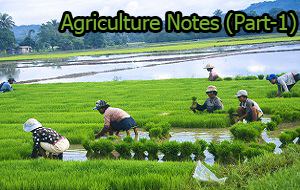
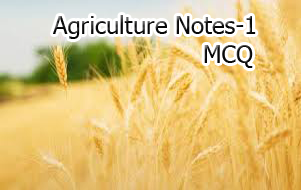



22 Comments
its very valuable nd vital notes for me… good work.. could you please send to me this data in pdf form
Sir can you send these notes on my email id..
Plz create pdf file all topic… Plzzz
We will upload pdf of this post soon
sir plz send me these agriculture notes by email. manmeet.gill4@gmail.com
SIR PLEASE PROVIDE MATERIAL IN PDF FILES OR E MAIL ME
Sir plz send me this notes by email
Sandeeptungwali@gmail.com
Please send in PDF form…
We will upload “Agriculture notes pdf” soon
Sir when u uploading these document in pdf for….could you send these pdf Notes to mine Enail Id: satnams181@gmil.com
sir reenue patwari ka xam kb h??koi idea??
Not sure, May be 2nd week of dec
Great work…….thanks
sir please can you send me these notes agriculture part-1&2 as pdf on my email id kaurtranum10@gmail.com
you can download pdf from “www.punjabexamportal.com/download/â€
plz snd me agriculture notes on my mail plz sir
you can download pdf from “www.punjabexamportal.com/download/”
Plzz provide me user name & password…i dnt able to download some of pdf file’s
Hey admin i don’t able to download some of pdf’s & plzz provide me user name & password, if its possible, bcuz patwari exam is on 24th jan… plzz if u can otherwise send in my mail id- i.e. anoopsingh1293@gmail.com
Thank you so much
send as pdf plz